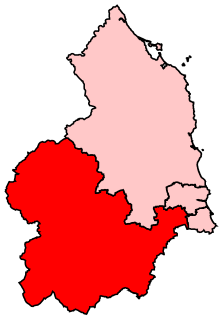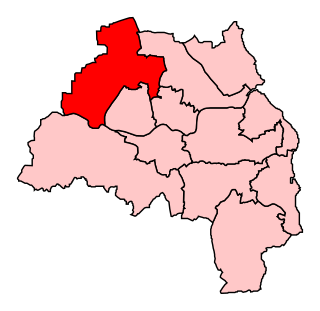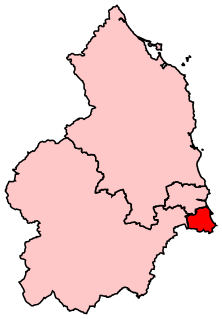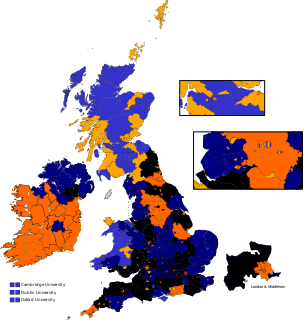Maps
- 1885-1918
- 1918-1950
- 1955-1983
- 2010-present
The county of Northumberland has returned four MPs to the UK Parliament since 1983. Under the Local Government Act 1972, which came into effect on 1 April 1974, the boundaries of the historic/administrative county were significantly altered with the south-east of the county, comprising more than half the electorate, being transferred to the new metropolitan county of Tyne and Wear. These changes were reflected in the following redistribution of parliamentary seats which did not come into effect until the 1983 general election, resulting in a reduction in the county's representation from 10 to 4 MPs.
The table below shows the number of MPs representing Northumberland at each major redistribution of seats affecting the county.
| Year | County seats1 | Borough seats1 | Total |
| Historic County | |||
| Prior to 1832 | 2 | 6 | 8 |
| 1832-1885 | 4 | 6 | 10 |
| 1885-1918 | 4 | 4 | 8 |
| 1918-1950 | 3 | 7 | 10 |
| 1950-1974 | 3 | 7 | 10 |
| Current County | |||
| 1974-19832 | 3 | 1 | 4 |
| 1983–present | 3 | 1 | 4 |
1Prior to 1950, seats were classified as County Divisions or Parliamentary Boroughs. Since 1950, they have been classified as County or Borough Constituencies.
2Approximate equivalent number of constituencies. Prior to the redistribution coming into effect for the 1983 general election, two constituencies were split between Northumberland and Tyne and Wear and two were wholly within the reconfigured county.
County seat Borough seat
| Constituency | Prior to 1832 | 1832-1885 | 1885-1918 | 1918-1950 | 1950-1974 | 1974-1983 | 1983–present |
|---|---|---|---|---|---|---|---|
| Northumberland | 1290-1832 (2 MPs) | ||||||
| North Northumberland | 1832-1885 (2 MPs) | ||||||
| Berwick-upon-Tweed | 1512-1885 (2 MPs) | 1885–present | |||||
| Morpeth | 1553-1832 (2 MPs) | 1832-1950 | 1950-1983 | ||||
| South Northumberland | 1832-1885 (2 MPs) | ||||||
| Wansbeck | 1885-1950 | 1983–present | |||||
| Blyth | 1950-1983 | ||||||
| Blyth Valley | 1983–present | ||||||
| Hexham | 1885–present | ||||||
| Tynemouth and North Shields | 1832-1885 | Part of Tyne and Wear from 1974 | |||||
| Tynemouth | 1885---> | ||||||
| Tyneside | 1885-1918 | ||||||
| Wallsend | 1918---> | ||||||
| Newcastle upon Tyne | 1283-1918 (2 MPs) | ||||||
| Newcastle upon Tyne East | 1918---> | ||||||
| Newcastle upon Tyne North | 1918---> | ||||||
| Newcastle upon Tyne West | 1918---> | ||||||
| Newcastle upon Tyne Central | 1918---> | ||||||
Since 1290, the Parliamentary County of Northumberland, along with all other English counties regardless of size or population, had elected two MPs (Knights of the Shire) to the House of Commons.
The county also included three Parliamentary Boroughs, namely Berwick-upon-Tweed, Morpeth and Newcastle upon Tyne, all returning two MPs (burgesses) each.
The Great Reform Act of 1832 radically changed the representation of the House of Commons, with the County being divided into the Northern and Southern Divisions, [1] both returning two MPs. [2] The representation of Morpeth, which included the parish of Bedlington, was reduced to one MP. [3] [4] Tynemouth was established as a single-member Borough [5] - named Tynemouth and North Shields under the Parliamentary Boundaries Act 1832. [6] [7]
Under the Boundary Act 1868, the boundaries of Morpeth were further extended to include the townships of Cowpen and Newsham (which incorporprated the town of Blyth). [8] [9] There were no other changes.
Under the Redistribution of Seats Act 1885, the two two-member county divisions were replaced by four single-member constituencies, namely Berwick-upon-Tweed, Wansbeck, Hexham and Tyneside. [10] The Parliamentary Borough of Berwick-upon-Tweed was abolished. [11] Tynemouth and North Shields became known as Tynemouth, [12] with no changes to its boundaries.
Under the Representation of the People Act 1918, the number of constituencies in Northumberland was increased back up to 10 as the two-member borough of Newcastle upon Tyne was replaced by four Divisions – Central, East, North and West. [13]
The County Division of Tyneside was abolished and its contents distributed as follows:
Elsewhere, Berwick-upon-Tweed gained Amble from Wansbeck and Rothbury from Hexham, and Ashington was transferred from Wansbeck to Morpeth. [15]
As a result of the redistribution enacted by the Representation of the People Act 1948, Northumberland's representation remained at 10 MPs. [16]
A new borough constituency named Blyth was established, which included the towns of Blyth and Bedlington, previously part of Morpeth. Wansbeck was abolished with its contents distributed as follows:
There was only one change resulting from the First Periodic Review of Westminster constituencies – the transfer of Benwell ward from Newcastle upon Tyne West to Newcastle upon Tyne Central. [17]
There were no changes resulting from the Second Periodic Review, which came into effect for the February 1974 election. [18]
Shortly after the Second Periodic Review came into effect, the county was subject to a major reconfiguration under the terms of the Local Government Act 1972. As a result, with effect from 1 April 1974, the four Newcastle upon Tyne constituencies and those of Wallsend and Tynemouth1, together with small areas of Hexham and Blyth, became part of the metropolitan county of Tyne and Wear.
1 Apart from the small community of Seaton Sluice.
The next change to parliamentary constituency boundaries, following the recommendations of the Third Periodic Review, reflected the change in county boundaries and reorganisation of local government authorities in 1974. [19] This review did not come into effect for a further nine years, at the 1983 general election, and resulted in the following changes:
There were no changes under the Fourth Review. [20]
At the Fifth Review there were only minor changes due to the revision of local authority ward boundaries. [21] [22]
The table below shows which constituencies represented major communities within the current county from 1885 onwards.
| Town | 1885-1918 | 1918-1950 | 1950-1983 | 1983-present |
|---|---|---|---|---|
| Alnwick | Berwick-upon-Tweed | |||
| Amble | Wansbeck | Berwick-upon-Tweed | ||
| Ashington | Wansbeck | Morpeth | Wansbeck | |
| Bedlington | Morpeth | Wansbeck | ||
| Berwick-upon-Tweed | Berwick-upon-Tweed | |||
| Blyth | Morpeth | Blyth | Blyth Valley | |
| Cramlington | Wansbeck | Blyth | Blyth Valley | |
| Hexham | Hexham | |||
| Morpeth | Morpeth | Wansbeck | ||
| Newbiggin-by-the-Sea | Wansbeck | Morpeth | Wansbeck | |
| Ponteland | Wansbeck | Hexham | ||
| Prudhoe | Hexham | |||
| Rothbury | Hexham | Berwick-upon-Tweed | ||
| Seaton Delaval | Wansbeck | Blyth | Blyth Valley | |

Northumberland is a county in Northern England, one of two counties in England which border with Scotland. Notable landmarks in the county include Alnwick Castle, Bamburgh Castle, Hadrian's Wall and Hexham Abbey.

Hexham is a constituency in Northumberland represented in the House of Commons of the UK Parliament since 2010 by Guy Opperman, a Conservative. As with all constituencies, the constituency elects one Member of Parliament (MP) by the first past the post system of election at least every five years.

Newcastle upon Tyne North is a constituency represented in the House of Commons of the UK Parliament since 2010 by Catherine McKinnell of the Labour Party.

Tynemouth is a constituency in Tyne and Wear represented in the House of Commons of the UK Parliament since 1997 by Sir Alan Campbell, a member of the Labour Party.

Wansbeck is a constituency represented in the House of Commons of the UK Parliament since 2010 by Ian Lavery, a member of the Labour Party.

Blyth Valley, formerly known as Blyth, is a constituency represented in the House of Commons of the UK Parliament since 2019 by Ian Levy, a Conservative.

Berwick-upon-Tweed is a parliamentary constituency in Northumberland represented in the House of Commons of the UK Parliament since 2015 by Anne-Marie Trevelyan, a Conservative.

Newcastle upon Tyne East is a constituency represented in the House of Commons of the UK Parliament by Nick Brown of the Labour Party. Brown has held the seat since its recreation in 2010.
Morpeth was a constituency centred on the town of Morpeth in Northumberland represented in the House of Commons of the Parliament of England from 1553 to 1707, the Parliament of Great Britain from 1707 to 1800, and then the Parliament of the United Kingdom from 1800 to 1983.
Newcastle upon Tyne West was a parliamentary constituency in the city of Newcastle upon Tyne from 1918 to 1983 which returned one Member of Parliament (MP) to the House of Commons of the Parliament of the United Kingdom.
Wallsend was a parliamentary constituency centred on Wallsend, a town on the north bank of the River Tyne in North Tyneside.

North Northumberland was a county constituency of the House of Commons of the Parliament of the United Kingdom. It was represented by two Members of Parliament (MPs), elected by the bloc vote system.

South Northumberland was a county constituency of the House of Commons of the Parliament of the United Kingdom. It was represented by two Members of Parliament (MPs), elected by the bloc vote system.
Newcastle-upon-Tyne was a parliamentary borough in the county of Northumberland of the House of Commons of England from 1283 to 1706, then of the House of Commons of Great Britain from 1707 to 1800 and of the House of Commons of the United Kingdom from 1801 to 1918. It returned two Members of Parliament (MPs), elected by the bloc vote system.
Tyneside was a parliamentary constituency in the Tyneside area of north-east England, which returned one Member of Parliament (MP) to the House of Commons of the Parliament of the United Kingdom, elected by the first-past-the-post voting system.

Prior to its uniform adoption of proportional representation in 1999, the United Kingdom used first-past-the-post for the European elections in England, Scotland and Wales. The European Parliament constituencies used under that system were smaller than the later regional constituencies and only had one Member of the European Parliament each.
Tynemouth and North Shields was a parliamentary borough constituency represented in the House of Commons of the Parliament of the United Kingdom between 1832 and 1885. It elected one Member of Parliament (MP) by the first-past-the-post system of election.
The ceremonial county of Tyne and Wear has returned 12 MPs to the UK Parliament since 2010. It was created under the Local Government Act 1972, which came into effect on 1 April 1974, comprising the urban areas around the mouths of the Rivers Tyne and Wear, previously parts of the historic counties of Northumberland and Durham.
{{cite web}}: CS1 maint: unfit URL (link)